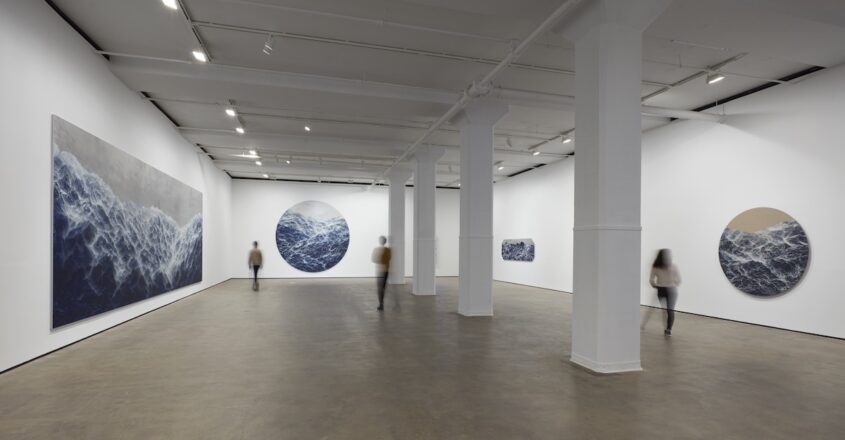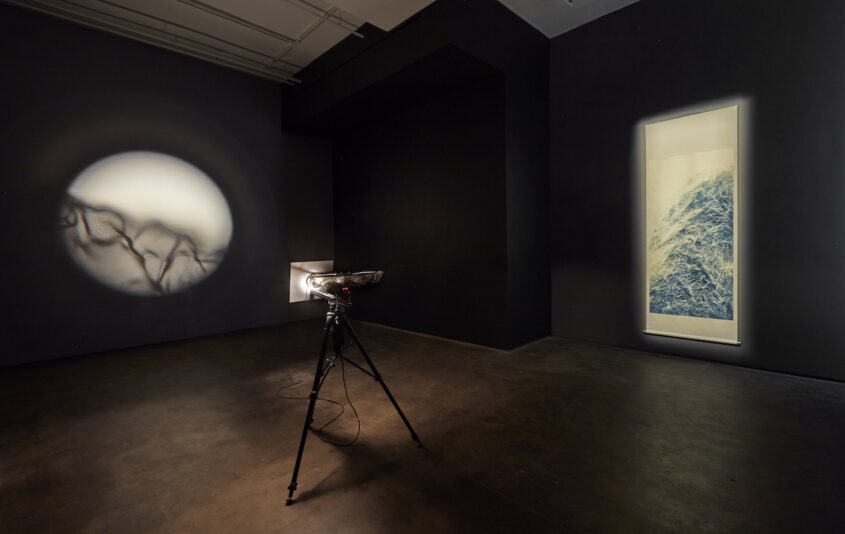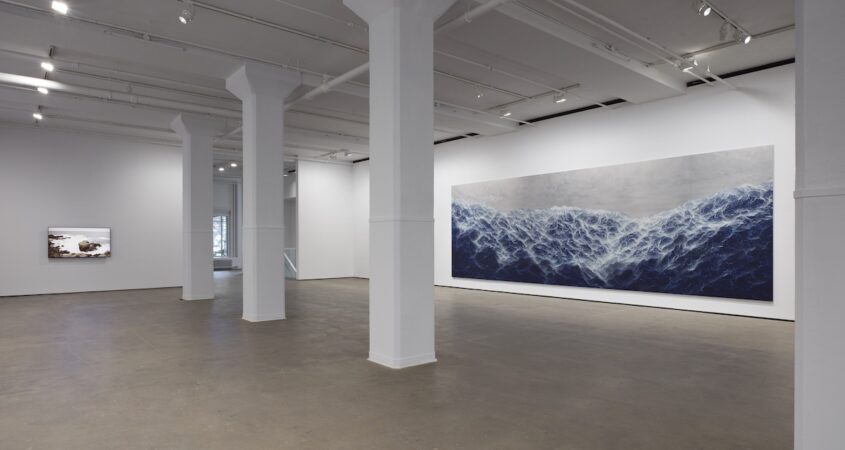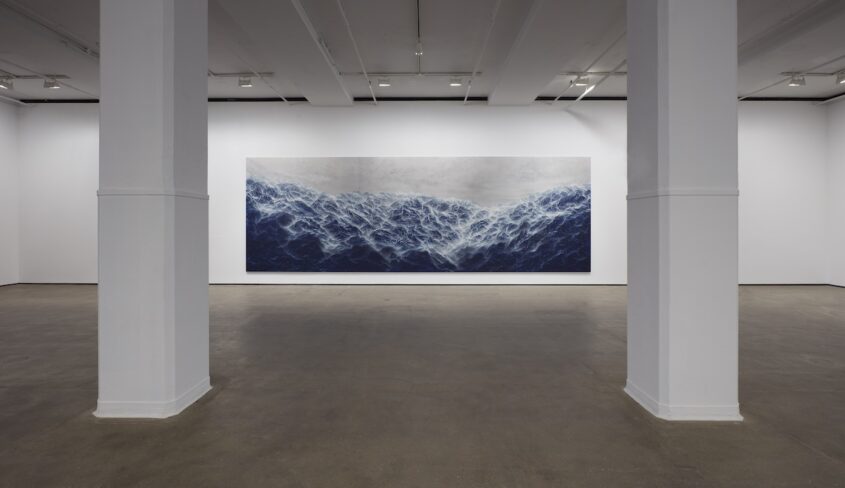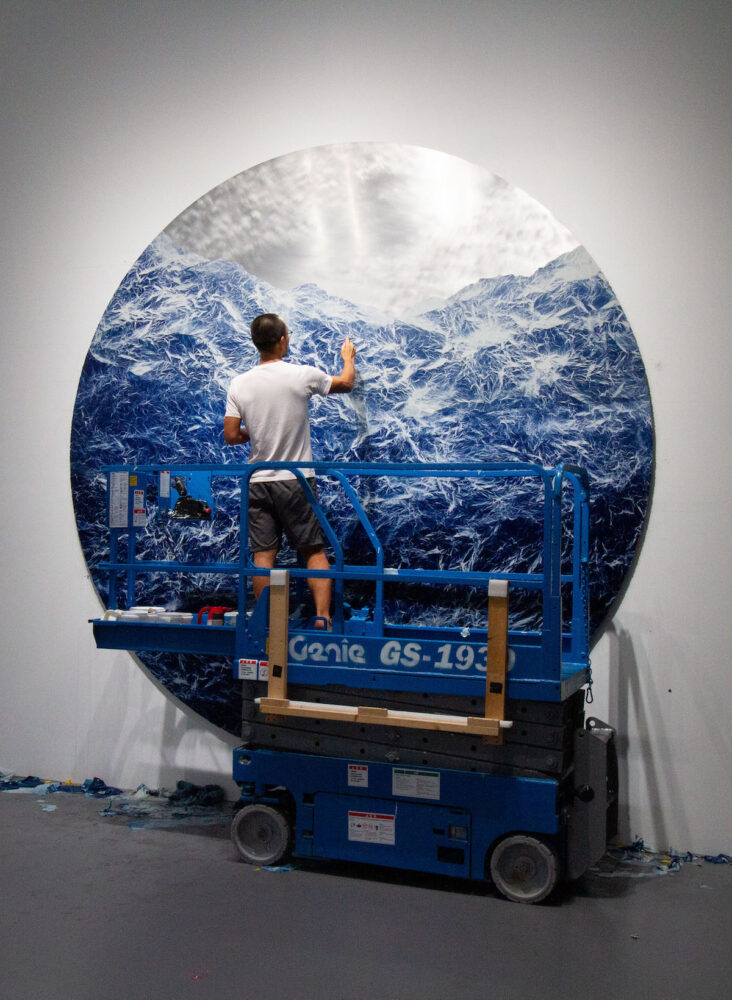
jing-atmospheres
Dates November 5 – December 18, 2021
Opening Reception Thursday, November 4, 6-8pm
Sean Kelly is delighted to present jing-atmospheres, Wu Chi-Tsung’s first solo exhibition in the gallery and indeed the United States. Chi-Tsung’s innovative body of work encompasses a broad range of media including photography, video, installation, and painting, in which he combines traditional and contemporary forms and methodologies to explore perceptions of the physical and natural worlds. This exhibition features new Cyano-Collages, videos, and an immersive film installation. There will be an opening reception on Thursday, November 4 from 6-8pm, the artist will be present at the gallery.
Wu Chi-Tsung was trained from an early age in the traditions of Chinese calligraphy, Chinese ink painting, watercolor, and drawing, and worked in these time-honored idioms for many years. While those practices still inform his process, Chi-Tsung’s current work seeks to understand how media and technology are manipulated to represent our relationship to the world. In the main gallery, there are new iterations of his Cyano-Collage series, in which he connects Eastern and Western culture and art to integrate traditional aesthetics within a striking contemporary language. His Cyano-Collages replace the traditional ink and brush used in Chinese shan shui paintings –literally, “mountain-water-pictures”—with experimental photography to reinvigorate the traditional landscape language. To create these stunning images, Chi-Tsung prepares hundreds of cyanotype photographic papers—Xuan paper treated with a photosensitive coating—that are crumpled, exposed to sunlight, and then mounted onto aluminum, creating a spectrum of tonalities. The results are collaged images that resemble the mountainous landscapes often found in Chinese shan shui paintings, but which are produced using completely a contemporary process.
Utilizing video, installation, and photography, Wu Chi-Tsung discovered in these new media compelling conceptual stratagems that spurred new and dynamic approaches to image making. Featured in the main gallery are two new films from Wu Chi-Tsung’s Still Life series, that conceptually translate motifs of traditional cut-branch flower painting into time-based moving images. Describing these works, Chi-Tsung stated that they are inspired, “by a cherished memory of painting; however, the mourning over this lost memory might not be limited to painting only. Some nameless emotions and memories unconsciously and slowly dissipate until, to our surprise, they are far away and cloaked by a white mist, their appearances obscured.”
In the front gallery, is a work from Wu Chi-Tsung’s Wire series, begun in 2003. Applying a structure similar to a magic lantern – an early type of image projector that used a light source, pictures printed on transparent plates, and one or more lenses – Chi-Tsung’s Wire VI, uses an automated mechanical control to repeatedly adjust the focal length of a camera trained on a single piece of wire mesh. A strong light illuminates the mesh and is directed through a large camera lens that projects a continually evolving image onto the wall. The result is a moving image that suggests an exquisite Chinese landscape. With this work, Wu Chi-Tsung explores how images change the way we see and imagine the outside world.
In the lower gallery, Chi-Tsung’s 2006 installation, Dust, investigates the artist’s deep concern with our relationship to images. A camera, positioned at one end of the darkened gallery, has its lens focused on the light of a projector installed at the opposite end of the room. The camera is focused on the center of the room and sends a live video signal to the projector. Thus, a recording of the reflection of the circulation of dust particles moving about the room are projected on the wall, wavering and glimmering. As viewers progress through the space, disrupting the flow of air, the images of flickering dust change constantly and instantaneously. The emerging and hidden images in Chi-Tsung’s work suggests a new relationship between artist and media, image and viewer.
Born in 1981 in Taipei, Wu Chi-Tsung currently lives and works in Taipei, Taiwan and Berlin, Germany. He was the recipient of the Liu Kuo Sung Ink Art Award, Hong Kong and Taiwan, 2019, the WRO Media Art Biennial, 2013 and the Taipei Arts Award, 2003. He was short-listed for the Prudential Eye Awards, 2015 and the Artes Mundi, 2006. His work has been included in international exhibitions at institutions such as the Mori Art Museum, Japan; the National Museum Cardiff, United Kingdom; the Long Beach Museum of Art, Los Angeles; the Casino Luxembourg – Forum d’art Contemporain, Luxembourg; the Museo Del Palacio De Bellas Artes, Mexico; the Central Academy of Fine Arts (CAFA) Art Museum, Beijing, China; Shanghai Art Museum, China; the Seoul Museum of Art, South Korea; the Minsheng 21st Century Museum, Shanghai, China; the Museum of Contemporary Art Yinchuan, China; the Hiroshima City Museum of Contemporary Art, Japan; the Ullens Center for Contemporary Art (UCCA), Beijing, China and the Taipei Fine Arts Museum, Taiwan amongst others. His work is included in renowned collections such as the Arario Museum, Seoul, South Korea; the Borusan contemporary, Istanbul, Turkey; the M+ Museum, Hong Kong, China; the Santa Barbara Museum of Art, Santa Barbara, California; the Spencer Museum of Art, Lawrence, Kansas; the The University of Salford Art Collection, Salford, United Kingdom; the Ullens Center for Contemporary Art, Beijing, China; the White Rabbit Gallery, Chippendale, Australia; the Yu Hsiu Museum of Art, Nantou, Taiwan and the Post Vidai Collection, Ho Chi Minh City, Vietnam.
Being listed as one of the ‘most exciting and thought-provoking’ show in New York area by the Artnet, Wu Chi-Tsung’s solo exhibition jing-atmospheres will be closing tomorrow.
Wu considers the New York show a very clear survey of his practice. The show features works that span his whole artist career, as early as the Wire VI which has been developed since he was a college student, as well as the installation work Dust, and as recent as the two huge Cyano-Collage Series that were conducted at the new Tamsui studio, and three video works.
Before the exhibition’s opening, Wu Chi-Tsung was interviewed by author Vivienne Chow at Artnet. Her article, titled Wu Chi-Tsung Is Drawing Global Notice for Revamping Chinese Landscape Painting With Video, Light, and a Big Dose of Chance reviewed Wu Chi-Tsung’s international journey after he realized that Taiwan is not big enough to contain his ambition.
The article states that Wu is now “among a small group of East Asian artists who are appearing on a world stage thanks to the attention of Western galleries. The accomplishment is even rarer for an artist of his age, and coming from Taiwan. While many leading Western galleries have set up shop in Asia, only a handful of them have brought relatively young Asian artists back to the dealers’ home turf in Europe or the U.S.”
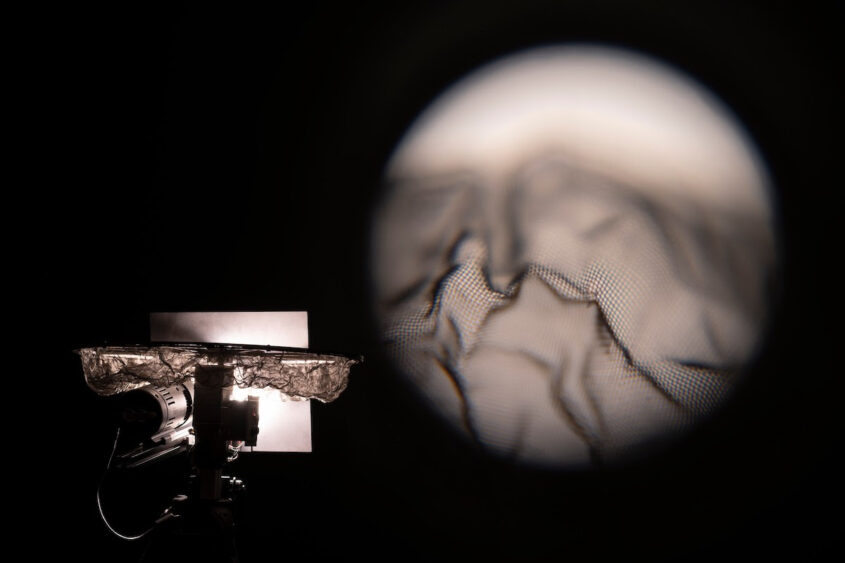
Wu Chi-Tsung has received art training from both Eastern and Western sources, which is a common upbringing in Taiwan.“We actually grew up bilingual, and it is unlikely that a Western artist would have practiced calligraphy and ink painting since childhood, but Asian artists are generally trained in Western art, and this is obviously our best characteristic and competitive advantage”, said the artist to Vogue Taiwan in an interview prior to the show. In addition, he has taken up artist residencies in several countries. In addition to the two studios in Taiwan, he has set up studios in Saigon and Berlin. The intensity of his experience in both Eastern and Western cultures, as well as the breadth of his vision has contributed to the fascinating diversity and openness in his works, from materials, aesthetic to concept. Whether to audiences from different cultures or professionals in the fields of new media, ink painting, or photography, his work always strikes them as a mixture of familiarity and surprise. By introspecting and outlooking, Wu Chi-Tsung has formed an unique artistic language that is rich and liberated, and free from language and cultural barriers.
Wu shared that, “I really hope this journey, one that has been full of trial and error in finding a way out, can inspire more young artists to go out to find opportunities, to see this big world.”
《境》
日期 2021年11月5日-12月18日
開幕酒會 11月4日(週四),下午6-8點
尚凱利畫廊榮幸呈現吳季璁在畫廊的首次個展《境》,這也是他在美國的首秀。吳季璁的充滿新意的創作橫跨多種媒材,包括攝影、錄像、裝置和繪畫,在這些作品中,他結合傳統與現代的形式和方法來詮釋他對現實和自然世界的思考。本次展覽將展出《氰山集》系列新作及藝術家代表性的裝置與錄像作品。開幕酒會將於11月4日星期四下午6-8點舉辦,屆時藝術家將蒞臨現場。
吳季璁從小接受中國傳統書畫與水彩、素描的訓練,這些來自東西方的傳統技法奠定了他的創作基調與思維方式,同時,他在創作中關注人與媒體、技術與之間相互操縱與控制的關係。展覽的主展廳將陳列《氰山集》系列新作,這一系列結合了東西方的美學與技法,將傳統融入了其充滿想象的當代語言中。藝術家使用「氰版山水」取代了傳統繪畫中的筆墨,以實驗攝影的形式重新詮釋了傳統的山水世界。他準備了數百張經過感光藥劑處理的宣紙,將之揉皺後暴曬於陽光下,通過控制曝光的強度與時長,宣紙得以顯現出不同色調,隨後,再將氰版相紙拼貼至鋁板上,藉此,他用完全現當代的工藝呈現出了與傳統山水如出一轍的詩意畫面。
吳季璁亦靈活利用影像、裝置和攝影等新媒體媒材,以傳達他對於「影像」的持續思考與探索。本次,《小品之十四 黃梅》也將在主展廳中呈現。據藝術家介紹,這一系列作品將傳統繪畫中的折枝花鳥畫轉化為時基影像,其靈感來自於「對繪畫的緬懷;但緬懷追悼的,或許不僅止於繪畫。某些無以名狀的情感和記憶,不知不覺中慢慢的消逝,等到你忽然驚覺,它們早已遠去,淹沒在一片白霧中,面目模糊難以辨識。」
在前廳展示的是開始於2003年的《鐵絲網》系列作品。這一系列采用了類似於幻燈(早期的圖像投影儀,由光源、印在透明板上的圖片與鏡頭組成)的結構:一片鐵絲網被強光照亮,相機鏡頭對準鐵絲網,一個自動機械裝置反復控制著相機的焦距,從而產生不斷變化的圖像並投射到墻上,而其呈現的畫面卻富有山水意境。藉此,吳季璁探索了影像如何改變我們看待和想象外部世界的方式。
在下層展廳展出的裝置作品《灰塵》(2006年)繼續著藝術家對於觀者與影像的關係的探索。黑暗展廳的一端是一台相機,其鏡頭對準安裝在房間另一端的投影儀的光源,並向投影儀發送實時信號。因而,房間內移動的灰塵顆粒被記錄並投射到幕布上,它們搖擺不定,閃閃發光。當觀眾在空間中前進,擾亂了空氣的流動,閃爍的灰塵的影像便會隨之不斷變化。這些若隱若現的影像傳達了藝術家對於媒體、影像和觀眾之間的關係的思辨。
吳季璁1981年生於臺北,目前在臺灣臺北和德國柏林生活和工作2019年獲港台劉國松水墨藝術獎、2013年波蘭媒體藝術雙年展藝評與藝術雜誌編輯獎(WRO)、2003年獲台北美術獎首獎。他曾入圍英國世界藝術獎(Artes Mundi,2006)、英國保誠當代藝術獎(Prudential Eye Awards,2015)。他的作品曾於日本森美術館、英國卡迪夫國家博物館、洛杉磯長灘美術館、盧森堡卡西諾當代藝術中心、墨西哥藝術宮、中國北京中央美術學院美術館、中國上海美術館、韓國首爾美術館、中國上海民生21世紀博物館、中國銀川當代藝術館、日本廣島市現代藝術館、中國北京尤倫斯當代藝術中心(UCCA)和臺灣臺北市立美術館等國內外藝術機構展出。他的作品被多家著名博物館收藏,如韓國首爾阿拉里奧美術館、土耳其伊斯坦堡的Borusan Contemporary Art Collection、香港的M+博物館、美國加州聖巴巴拉藝術博物館、斯賓塞藝術博物館、英國索爾福德大學藝術館,英國索爾福德市、中國尤倫斯當代藝術中心、澳大利亞白兔美術館、台灣南投毓秀美術館、越南Post Vidai Collection等。
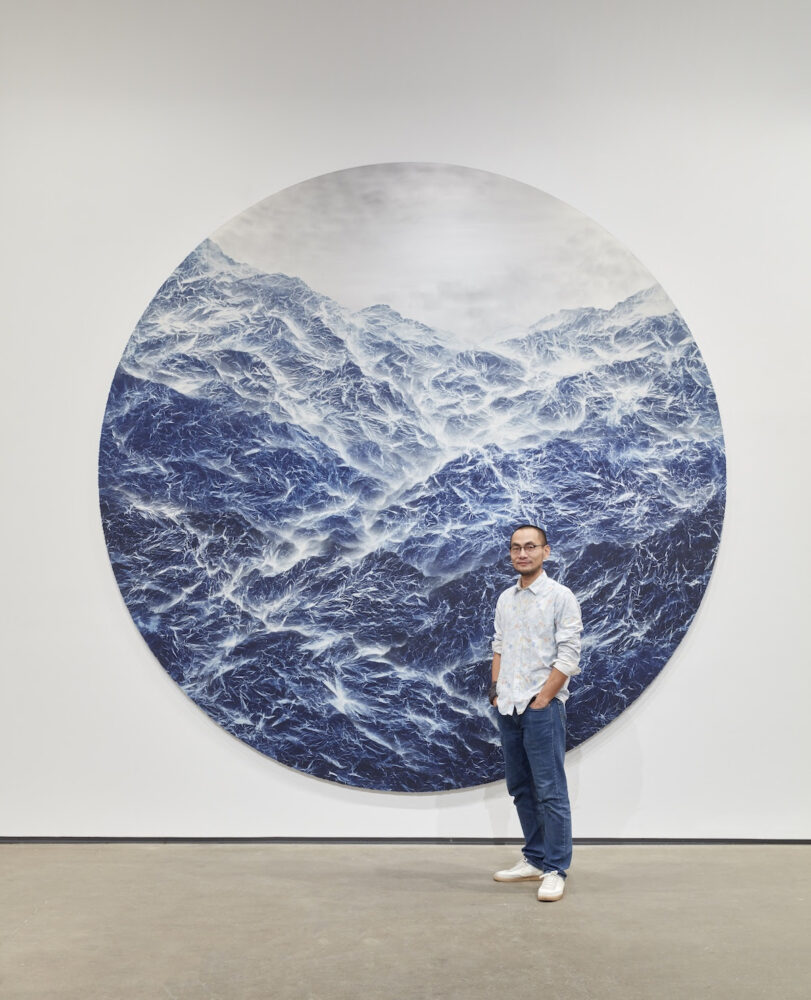
Photography: Jason Wyche, New York, Courtesy: Sean Kelly, New York
個展《境》,被Artnet News列為紐約地區「最激動人心與令人深思」的展覽之一。
對於吳季璁而言,尚凱利策劃的展覽是對其創作的完整梳理,展出作品跨越了他的整個藝術生涯——早至他從學生時代便開始創作的《鐵絲網》系列、裝置作品《灰塵》、近至他在淡水新工作室完成的兩件巨幅《氰山集》系列,與三件錄像作品。
展覽開幕前,吳季璁在畫廊接受了Artnet作者Vivienne Chow的專訪。文章標題點出吳季璁「以其由光、影和隨機性組成的水墨創作贏得了全球注目」,並回顧了藝術家在「不滿足於台灣的發展空間」後進行的國際化探索。
Artnet文章介紹,吳季璁是 「極少數受到西方畫廊關注並活躍於世界舞台上的東亞藝術家之一。對於這個年紀且來自台灣的藝術家而言,這個成就更屬罕見。目前,雖然許多頂尖西方畫廊已經進軍亞洲,但是只有少數畫廊會將較為年輕的亞洲藝術家帶到歐美的主戰場辦展」。
吳季璁從小接受東西方兩種脈絡的藝術訓練,他在此前接受《Vogue台灣》採訪時曾表示,「我們其實是學雙語長大,西方的藝術家不大可能從小練書法,畫水墨,但亞洲藝術家的養成普遍也受西方藝術的訓練,這顯然是最好的特色跟競爭優勢。」
除此之外,他曾於歐美多國駐村、並在越南西貢與柏林均成立工作室,對於東西文化的理解,加上其視野的廣度,令他的作品從材料、美學風格至哲學內在始終具有迷人的多元性與開放性。無論對於來自不同文化的觀眾,還是新媒體、水墨或影像,及當代藝術等各領域的專業人士,都可以在不同的理解脈絡下,投射他們各自對作品的想像。吳季璁透過東西方文化底蘊所創造出豐富自由、不受語言與文化所限制的藝術表現,帶領他穩健踏實地走向國際舞台。
吳季璁分享道,「希望這段探索國際藝術世界的冒險旅程,可以激勵更多年輕藝術家們往外發展,在廣闊的天地中闖蕩。」
Read More 延伸閱讀
New York Solo Exhibition jing-atmospheres List as Editors’ Picks by Artnet
紐約個展《境》被ARTNET列為編輯精選藝術活動
Ocula: Wu Chi-Tsung’s Xuan Paper Collages Open Up Many Visual Possibilities
OCULA展評:吳季璁之「境」
Interview with Artist Wu Chi-Tsung: Art is never a Blank Sheet of Paper
Vogue台灣專訪藝術家吳季璁,藝術從來不是白紙一張的事
Wu Chi-Tsung’s Solo Exhibition jing-atmospheres at Sean Kelly New York
美國首次個展《境》於尚凱利畫廊
Installation view 展覽現場
